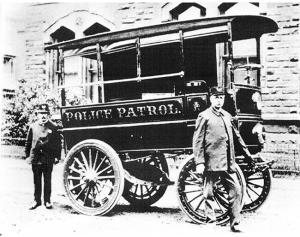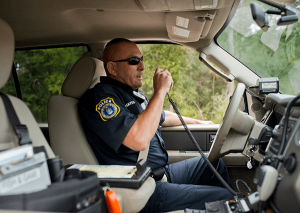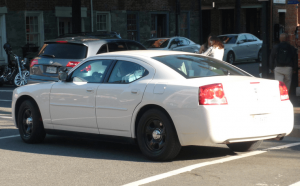The Evolution of the Humble Police Car
Posted by Extreme Tactical Dynamics on Jun 29th 2019
With sirens blaring and emergency lights flashing, no one wants to be speeding down a road with a police car hot on their tail. If you ever see a police car flashing their lights at you with their siren on full blast, then you better hope they’re just pulling you over for something minor.
But where did these police cars come from? When did they start to equip them with an emergency led light bar? It makes sense when you think about it in modern terms. With everyone in cars and fast vehicles, the police need to have equally fast cars in order to catch up with criminals and wrong-doers. In fact, some police forces in the world go as far to use sports cars in their fleets in order to catch criminals. For instance, police in Dubai have the pleasure of driving a Bugatti Veyron, a Ferrari FF and even a Lamborghini Aventador for their patrols. Equipped with the latest policing technology, painted in the colors of the Dubai police force and equipped with flashing LED light bars, these are cars you do not want to be engaged in a chase with.
 The First Police Car
The First Police Car
Of course, police cars weren’t always like this. In fact, the police car has humble beginnings that date back to 1909. Frank Croul, the Police Commissioner of Detroit, Michigan, saw the rise of the auto industry thanks to Ford, Studebaker, Packard and Cadillac having their main quarters in close proximity to the Commissioner’s base of operations. As Croul saw the growing number of cars driving around the city streets, he contemplated if they would have any use for the police.
However, he wasn’t the first person to think of that possibility. In 1899, a battery-powered “paddy wagon” was commissioned for $2,400 (roughly $65,000 today) that contained a stretcher, a cage for prisoners, headlights and even a gong. It was the first horseless police vehicle in America, but it wasn’t exactly a great success. It wasn’t very fast, it didn’t go very far before the batteries had to be recharged, and it was eventually pushed into a canal during a race riot by an angry mob. It was eventually fished out and returned to service, but another one was never built.
Croul knew about the failure of the first police vehicle, but that didn’t stop him from dreaming up new possibilities thanks to the improvements in newer models thanks to gasoline engines. Cars were faster, more reliable and actually affordable. Gas-powered vehicles were becoming a lot more common, so Croul decided it would be a good time to invest in a car for the Detroit Police Department. Sadly, the city turned his request down. They didn’t believe that a “police car” would help the force, so what did he do? Invested $5,000 (more than $100,000 today) of his own money and bought the force a Packard to use.
Early Days of the First Successful Police Car
Croul was right. His trusty new Packard was far more useful than the failed paddy wagon that was deployed in Ohio. It was faster, more reliable and require less maintenance than a police horse. It enabled the police force to get around much faster and the results showed. After just a couple of months, the city gave Croul his money back and placed an order to buy another six Packards for the force. Sooner or later, horse-drawn vehicles were out of the picture and gasoline-powered automobiles were in.
However, that’s not to say that there were no issues with the vehicles. Back then, these vehicles weren’t known as police cars but patrol cars. Sadly, due to a lack of remote communication, these cars would generally stay in close proximity to their station until the officers had an emergency call. Once a call came in, the officers would drive to the location, deal with the emergency and then drive back. As you can tell, this was horribly inefficient and caused many delays in the reaction speeds of the officers.
To counteract this, the Detroit Police Department decided to set up special telephone kiosks around the city that were exclusively used to remotely transfer information and emergency calls to officers that were actually patrolling the city, not just staying in one place. Officers worked in pairs; one would patrol on foot around the kiosk while their partner would be stationed at the kiosk. Once a call came in, the officer would hop into their patrol car, pick up their partner, then go together to the scene of the emergency. This technology was expanded to include special red lights at major intersections. These lights would flash or light up when an emergency call was coming in, signaling them to head to the nearest police call box to receive their orders.
 Advances in Radio Technology
Advances in Radio Technology
Although the entire system was clever, it was clear that having portable radios inside of each car would be the next step up to increase policing efficiency. Sadly, until 1921, this didn’t even seem possible. You see, radios were incredibly bulky and wouldn’t have worked well in an old vehicle that bounced around and vibrated a lot. It caused a lot of static interference and cars couldn’t provide enough power for radios. Not to mention that the radios themselves were extremely fragile and would’ve ended up breaking in a car in the 1920s.
However, in 1921, a Detroit police officer made a breakthrough. Patrolman Kenneth Cox teamed up with Robert Batts, a Purdue graduate, to create the very first police radio system in Detroit. Much like the radios we see in our cars nowadays, it was a one-way system. The cars could receive signals, but not send them. After many years of trial and error, it was finally installed in April 1928.
Detroit Police Department went on to make history as the first police department to dispatch patrol cars by radio. The police department had to create their own station, KOP, in order to communicate with patrol officers. The radio station itself was broadcasted as an entertainment station because the police did not have their own designated band. Because of the Federal Radio Commission licensing requirements, this meant that the broadcast had to play music in between orders and lists of stolen vehicles or descriptions of missing people. Fortunately, the FRC realized that this was a ludicrous requirement for law enforcement and soon stopped asking the Detroit Police Department to play music on its radio channel.
In 1933, engineers that worked for the Bayonne (New Jersey) Police Department developed the first two-way police radios. After a couple of years, well-known brands such as General Electric and Motorola started manufacturing police radios for departments all over the country. They cost around $700 a piece so they weren’t exactly cheap. In fact, they cost more than some police cars did, but they became crucial pieces of equipment for every police force. In fact, some police siren systems comes complete with a radio and PA system.
 Undercover Cars
Undercover Cars
Since police cars were the same vehicles that consumers could buy, they didn’t exactly look very different. They might have had the word “POLICE” painted on the side, but there were no patterns, extra lights or anything to distinguish a police vehicle from a regular consumer vehicle unless you looked up close. Some cars had sirens, but there wasn’t enough power in the vehicle to power them–they were cranked by hand. In fact, the Detroit Police Department issued their officers with loud whistles instead of sirens.
One way for civilians to spot a police vehicle was to see who was inside of the vehicle. New York City’s first police vehicles were convertibles, meaning they could see clearly who was driving the vehicle. In the 1920s, some police departments started painting their vehicles with special schemes in order to stand out. For instance, New York Police Department’s vehicles had green bodies, black front fenders, and white roofs. It wasn’t until the 1930s that the entire country adopted a similar style of black cars with white doors and roofs. These were the first black and white police cars, and the style has remained similar since.
Emergency Lighting
For extra visibility, police cars began to add spotlights on their vehicles. This was added as soon as the cars produced enough energy to power both the vehicle and the lights themselves. These were just static lights, not the led strobe light bar that you see nowadays on police vehicles. Red police car lights weren’t commonplace until the 1930s.
The very first rotating light, known as the gumball light, was officially known as the Beacon Ray. It was introduced in 1948 as a red light with blue added much later. It was a popular choice as a police car strobe up until the 1960s when police departments started replacing the gumball lights for the light bars that you see in today’s police vehicles. In addition to the light bar, departments started adding police car sirens and more complicated light bars that could reflect their light to wherever they wanted.
Modern Day Police Cars
Since then, police cars haven’t changed much. They’ve come a long way since the paddy wagon that was made in 1899, but since the 1960s when police departments switched to light bars, not much has changed outside of a few optimizations and technological upgrades here and there. In the 1950s, some manufacturers started offering “police packages” to law enforcement departments. These packages included extras such as improved brakes, durable tires and better steering. New technology such as visor emergency lights allow for police to operate undercover vehicles as well.
Nowadays, modern police vehicles in America contain a wealth of different features. For instance, there’s the same two-way radio (albeit slightly upgraded) that has been standard in police cars since 1933. However, it’s now housed in an equipment console that contains switches for lights and sirens. There’s a mobile data terminal in each police vehicle that can be used to request vehicle license details, criminal records and other logs that could be useful to officers. There are also advanced pieces of technology such as speed recognition devices to measure the speed of vehicles ahead of the officer, Automatic Number Plate Recognition software and firearm lockers that house tactical firearms. There’s even an enclosure in the back to detain suspects.
There are also several different vehicles in a fleet of police cars. There are Sports Utility Vehicles (SUVs) that can hold a lot more equipment or transport K-9 units, there are patrol cars that are light and capable, response cars that are much faster and are fitted with advanced technology to help track criminals, and also traffic cars that are responsible for enforcing traffic laws and are much more capable of catching up to speeding offenders.
Some Final Words
The future of the police car is uncertain. Currently, law enforcement agencies are experimenting with vehicles that have all of the equipment (lights, siren, gun racks, radios, night vision) built into the vehicle itself instead of converting existing vehicles. Other police forces around the world are experimenting with faster vehicles (such as Dubai's police force) and others are expecting to reduce carbon emissions by converting Tesla vehicles into police cars. Either way, police cars will continue to evolve in order to keep citizens safe and sound and they’ll always look for ways to stay one step ahead of criminals.
Related Posts
- Emergency Lights Help First Responders with the Move Over Law
- Popular Off Road Lights for Pickup Trucks
- Mini Light Bars are Perfect for Construction Company Vehicles
- Putting Together A Police Light Package
- Top 5 Emergency Vehicle Lights for Volunteers
- Cue The Lights: A Run-Down Of Vehicles That Employ Emergency Lighting
 Facebook
Twitter
Google+
Instagram
YouTube
Facebook
Twitter
Google+
Instagram
YouTube

